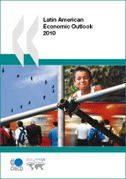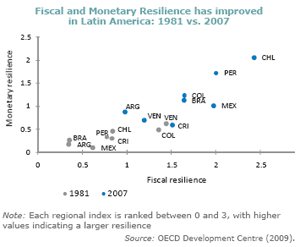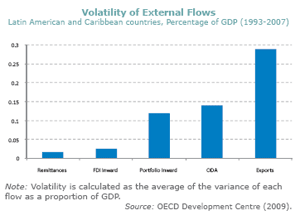Puerto Rico
Latin American Economic Outlook 2010
Contents | Related publications and downloads | How to obtain this publication
Additional info | Contacts | Learn more about LEO
|
Lisbon 30 November Hotel Cascais Miragem |
Madrid 2 December |
10 December Maison de l'Amérique latine |
|
9 March Funglode |
26 March CASS/ILAS |
Mexico 10 April OECD Mexico Centre |
|
8-10 April |
13 April |
Mexico 19 April |
|
Lima, Peru 3 May |
|
|
Bookmark this page: www.oecd.org/dev/publications/leo
|
Trade and financial resilience, rather than exposure, will allow countries to emerge from the crisis stronger. The OECD Latin American Economic Outlook 2010 provides a fresh analysis of economic trends in the region with a particular focus on the role that international migration and remittances play in fostering development.
|
|
|
Promote open and resilient economies Latin American countries that opened their markets to international competition during the last decade have not been more vulnerable to the global economic crisis. Instead, trade and financial openness have been accompanied by the creation of resilience mechanisms that allow more space to fund counter-cyclical policies. Fiscal and monetary measures, however, should be sustainable and not compromise macroeconomic fundamentals; nor should they reverse the progress made during the past five years in reducing poverty. |
|
|
Did you know? |
|
|
Did you know? While only 15% latin American immigrants are covered by social security agreements between origin and destination countries, 98% of workers moving within OECD high-income countries enjoy such portability benefits. |
Extend social protection for migrants Changing patterns of international migration will affect the depth of the crisis and its impact in Latin America. International migration can help curb unemployment and boost economic dynamism in the region if destination countries promote legal and flexible access for migrants to their labour markets better aligned with their labour demand. Mobility can be encouraged through programmes that provide the right incentives and that guarantee the portability of social benefits across borders. |
|
Boost competition to lower remittance costs Despite recent progress, the costs of remittance transfers to Latin America can and should be further reduced. Even a small cutback in the cost can yield substantial benefits for migrants and their families. More competition and a clearer regulatory framework for operators transferring remittances via mobile phone payments could help lower the cost and be an incentive for sending remittances through formal channels. |
Did you know? A reduction of just 1% in the average transfer cost of remittances could shift up to USD 800 million from transfer companies to migrants’ families..
|
|
Did you know? More than half of Latin American workers are not entitled to pension rights through their jobs. |
Tap remittances' potential for financing As consumption and investment are affected by the crisis, remittances can provide an important boost to domestic demand and financial development in Latin America. Despite their recent slowdown, remittances are far less volatile than other external flows; they also tend to benefit poorest families hardest hit by the crisis. Policies must capitalise on the ability of remittances to expand access to financial services among those traditionally excluded, lower investors’ perception of risk associated with investing in the region and help fund development projects that spur investments in human capital. |
|
Migration Country Notes and Database on Immigration*
Access the Database on Immigration (DIOC/E), which includes 15 Latin American Countries, 28 OECD and 12 other non-OECD countries. DIOC/E is composed of the following 3 tables (csv format):
Table 1: Immigration Basic Demographic Variables Table 2: Immigration Labour Force Table 3: Immigration Occupation
* These data were compiled by the OECD Development Centre for the Latin American Economic Outlook 2010, following the methodology established by the Database of Immigrants in OECD Countries (DIOC), produced and maintained by the OECD Directorate of Employment, Labour and Social Affairs (DELSA). The extension of the DIOC methodology to these Latin American countries was a collaborative effort of the Development Centre and DELSA. |
Related Publications & Downloads
- Executive Summary: Latin American Economic Outlook 2010
- LEO in 60 seconds
- Latin America in 2010: Migration policies for development (OECD Policy Brief)
- Speech of the OECD Secretary-General Angel Gurría for the launch of LEO (in Spanish and Portuguese)
Video and Podcast Interviews
How to obtain this publication
- Browse free online and purchase via our OECD Online Bookshop.
-
Subscribers and readers at subscribing institutions can access the online edition via SourceOECD.
-
Government officials with accounts can browse OLISnet, under "books" tab.
- Accredited journalists can access by password.
- Check the Distribution list in Latin America of the Latin American Economic Outlook.
- For specific requests, please contact: [email protected]
Please contact the Development Centre at [email protected].
Interested institutions are invited to contact Angel Alonso ([email protected], +33 1 45249411).
Related Documents


